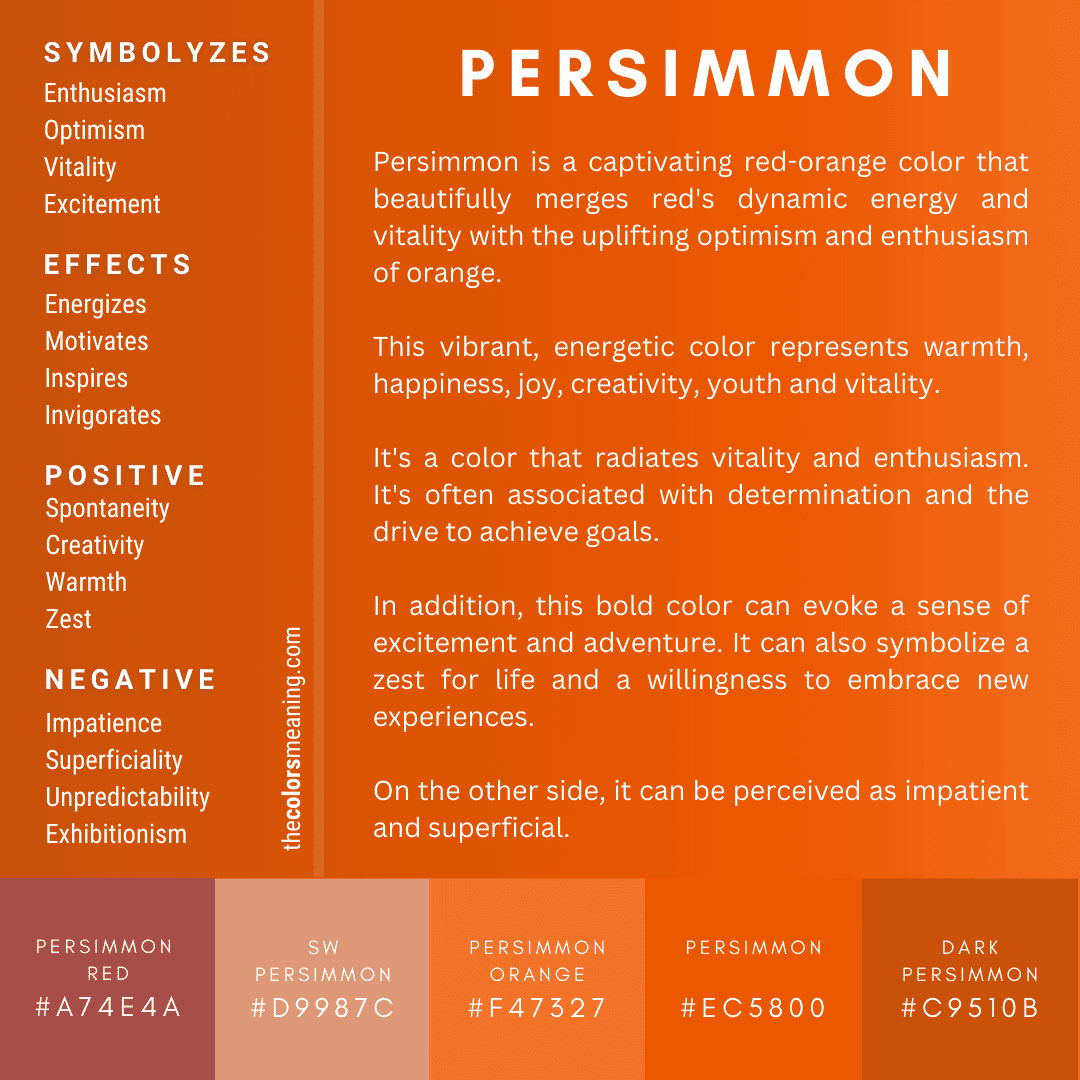Persimmon, a warm, earthy color that is gaining popularity in interior design, is both refreshing and uplifting. Furthermore, the persimmon color is an excellent choice if you want warmth, sophistication, and an exotic flair.
This captivating hue, reminiscent of the luscious fruit it’s named after, has captivated many industries, from fashion to home decor.
Not surprisingly, Sherwin Williams nominated one of its persimmon shades as the color of the year.
In this article, we’ll discuss the persimmon color, exploring its history, psychological meaning, color codes, and similar shades. We’ll also discuss the colors that go with persimmon.
What Color is Persimmon?
Persimmon color is a bold reddish-orange color named after the persimmon fruit. It was first used as a color name in English in 1922. However, this warm, vibrant shade can range from pale pink-orange to deep orange-red.

Persimmon Color Codes
| Code | Value | HTML/CSS |
|---|---|---|
| Hex | EC5800 | #EC5800 |
| RGB | 236, 88, 0 | rgb(236, 88, 0) |
| HSL | 22°, 100%, 46% | hsl(22, 100%, 46%) |
| HSV | 22°, 100%, 92% | |
| CMYK | 0, 63, 100, 7 |
History of Persimmon Color
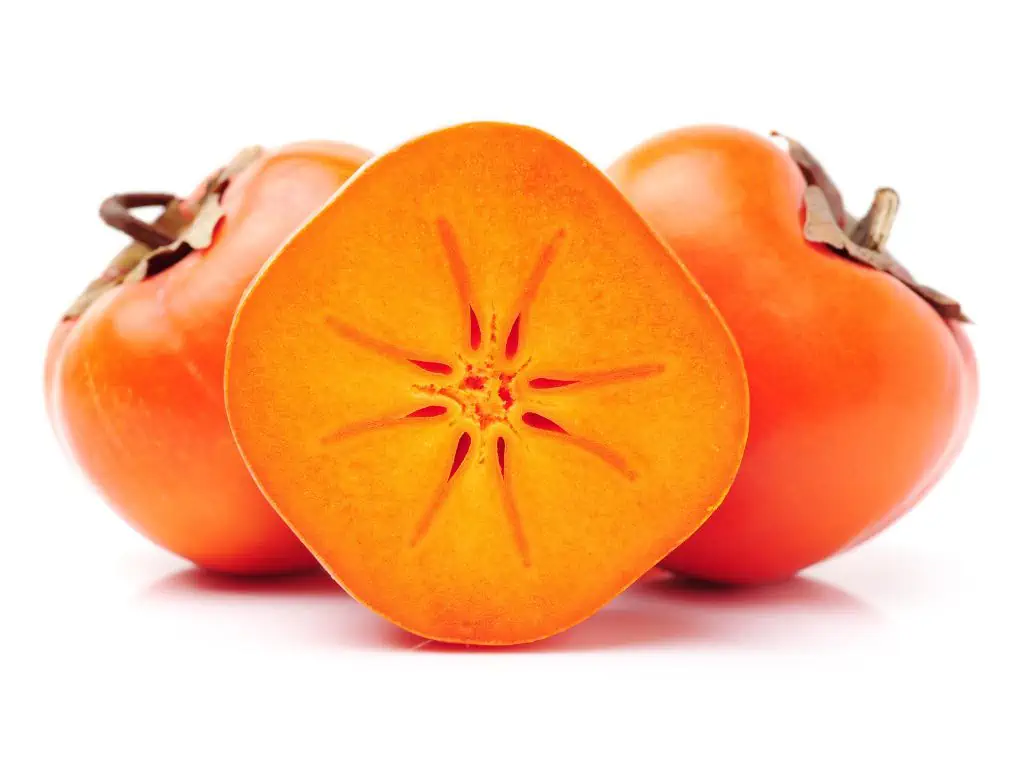
To understand the meaning of persimmon color, let’s first explore its origins.
The persimmon fruit, native to China, is the primary inspiration for this color. Part of the berry family, this fruit was first cultivated in China 2,000 years ago and introduced to Japan in the 7th century.
Also known as Japanese peach, this exotic fruit has a flavor similar to peach and pineapple.
It has also been called the food of Zeus because it is high in antioxidants, vitamin C, magnesium, and potassium.
Moreover, persimmons contain tannins, and some studies suggest that the tannins found in persimmons may have bacteriostatic and anti-inflammatory effects.
Bacteriostatic effects can inhibit the growth and reproduction of bacteria, potentially helping to prevent infections. On the other side, its tannins may reduce body’s inflammation, which can be beneficial for various health conditions.
Despite its close connection with the fruit of the same name, this color name only appeared in the 19th century.
Persimmon was first used as a color name in English in 1922, resembling the flesh of the fruit of the same name. Since then, its vibrant orange-red hue has been a source of fascination for color-lovers.
Persimmon Color Meaning
Persimmon is a playful and energetic color that combines the enthusiasm of orange with the energy of red. Persimmon symbolizes warmth, optimism, confidence, happiness, joy, creativity, youth and vitality. On the other side, it can be perceived as impatient and superficial.
Thus, as a shade of orange-red, it shares similar meanings and symbolism with orange and red.
Happiness and Joy
Since yellow is part of any orange, this color evokes feelings of optimism, happiness, and creativity.
It also features a sense of cheerfulness associated with positivity and joy.
Enthusiasm and Emotion
Persimmon symbolizes enthusiasm and emotion. It’s a vibrant and bold color that can evoke feelings of energy and excitement. It also inspires motivation and a zest for life.
Often seen as a color of youth and optimism, this hue also has some qualities from red, symbolizing confidence and strong emotions.
Optimism and Confidence
Persimmon is a stimulating and energetic color combining the vitality and confidence of red with the optimism and spontaneity of orange. It’s a joyful color that sees only the full side of the glass.
However, this positivism could make it perceived as superficial and impatient.
Energy and Vitality
This color exudes a vibrant and lively energy that instantly draws attention and creates a sense of liveliness in its surroundings. In addition, this hue exudes energy and vitality, encouraging action.
Like yellow, it radiates happiness and enthusiasm, exuding a vibrant and joyful aura. At the same time, it shares the physical stimulation and energy associated with the color red.
Warmth and Comfort
As a mixture of orange and red, sometimes with brown tones, persimmon combines the warmth of orange and the comfort of brown, evoking feelings of coziness and security. Its presence creates an inviting atmosphere in any setting.
This color is celebrated for its ability to infuse warmth into any space or design.
Longevity and Good Fortune
In Chinese culture, persimmons symbolize longevity and are believed to bring good fortune. The fruit’s deep color represents a rich and fulfilling life.
As a gesture of conveying joy and well-wishes, persimmons are also exchanged as gifts. Moreover, this color is often used in interior design following Feng Shui principles to attract positive energy.
Transformation
Persimmon’s shade mirrors the fiery tones of autumn leaves. This connection to the changing seasons makes it a symbol of transformation, reminding us of the cyclical nature of life.
Shades of Persimmon
Persimmon
Persimmon
Hex #EC5800
RGB 236, 88, 0
CMYK 0, 63, 100, 7
Light Persimmon
Light persimmon is a pale variation of red-orange with coral undertones. This pastel version can also be found as Pantone Persimmon 16-1544 TPX.
Light Persimmon
Hex #F5786B
RGB 245,120,107
CMYK 0, 51, 56, 4
Pantone Persimmon
Pantone Persimmon is a vibrant and warm coral-orange hue known for its lively and energetic qualities. It’s slightly lighter than Living Coral, named the Pantone Color of the Year for 2019, due to its inviting and optimistic nature. Its color code is 16-1544.
Pantone 16-1544 Tcx
Hex #F67866
RGB 246, 120, 102
CMYK 0, 49, 56, 4
Medium Persimmon
Medium Persimmon is a vivid and lively shade of orange with a slight reddish undertone. It has a bold and energetic look, exuding warmth, enthusiasm, and creativity.
Pantone 16-1356 Tcx
Hex #F47327
RGB 244,115,39
CMYK 0, 51, 80, 4
Persimmon Red
Persimmon red is a deep brownish red created by the Behr company as a paint color. Its color code is HDC-CL-09.
Persimmon Red
Hex #A74E4A
RGB 167, 78, 74
CMYK 0, 53.3, 55.7, 34.5
Mystic Red
Despite its name, this is a bold and vibrant red-orange color, similar to tangelo.
Mystic Red
Hex #FF5500
RGB 255, 85, 0
CMYK 0, 67, 100, 0
Persimmon Orange
Persimmon orange is a deep reddish-orange created by Pantone. It has the highest amount of yellow in the CMYK space after the original persimmon color. Its Pantone color code is 16-1356 TCX.
Persimmon Orange
Hex #F47327
RGB 244, 115, 39
CMYK 0, 53, 84, 4
Persimmon – Sherwin Williams 2024 Color of the Year
Persimmon by Sherwin Williams is an earthy apricot color with a warm, uplifting undertone. It’s happy, cozy and comfortable. It can also be described as a tangerine-tinged terra cotta. No wonder it’s Sherwin Williams 2024 Color of the Year. Its color code is SW 6339.
Sherwin Williams Persimmon
Hex #D9987C
RGB 217, 152, 124
CMYK 0, 30, 42.9, 14.9
Dark Salmon
Dark Salmon is a warm and muted shade of orange-pink. It resembles the color of cooked salmon, so it is named as such.
Dark Salmon
Hex #E9967A
RGB 233, 150, 122
CMYK 0, 35.6, 47.6, 8.6
BM Persimmon
Persimmon by Benjamin Moore is a muted orange-red color, similar to antique pink. Its color code is 2088-40.
Benjamin Moore Persimmon
Hex #BD6D64
RGB 189, 109, 100
CMYK 0, 42.3, 47.1, 25.9
Tangelo
Tangelo
Hex #F94D00
RGB 249, 77, 0
CMYK 0, 69, 100, 2
Dark Persimmon
Dark persimmon is a brownish-orange color, similar to tawny – a shade of brown. It can also be described as a deep orange with a brownish tint.
Dark Persimmon
Hex #C9510B
RGB 201, 81, 11
CMYK 0, 60, 95, 21
Scarlet Ibis
Scarlet Ibis a bright red-orange color named after the color of the scarlet ibis bird, known for its vibrant scarlet-colored plumage with black wingtips. This bird is native to tropical South America and the Caribbean. It’s reddish than persimmon.
Scarlet Ibis
Hex #F45520
RGB 244, 85, 32
CMYK 0, 65, 87, 4
Autumn Blaze
Autumn Blaze is a rich and deep orange with a warm undertone. This paint color was created by Valspar and its color code is 2002-1A. It can be described as a fiery, autumnal hue, often resembling the vibrant colors of leaves during the fall season.
Autumn Blaze
Hex #E55B2B
RGB 229, 91, 43
CMYK 0, 60, 81, 10
What Colors Go with Persimmon?
Persimmon pairs well with jade green, turquoise, forest green, baby blue, mustard, gray, beige, and brown. It also goes well with metallics, like gold and brass.
Jade
The complementary color to persimmon is blue-green. You can pair jade, teal, or turquoise to create a striking and balanced look. Here, the cool, serene green of jade pairs lovely with the warmth of persimmon, creating a sense of balance and tranquility in your space.
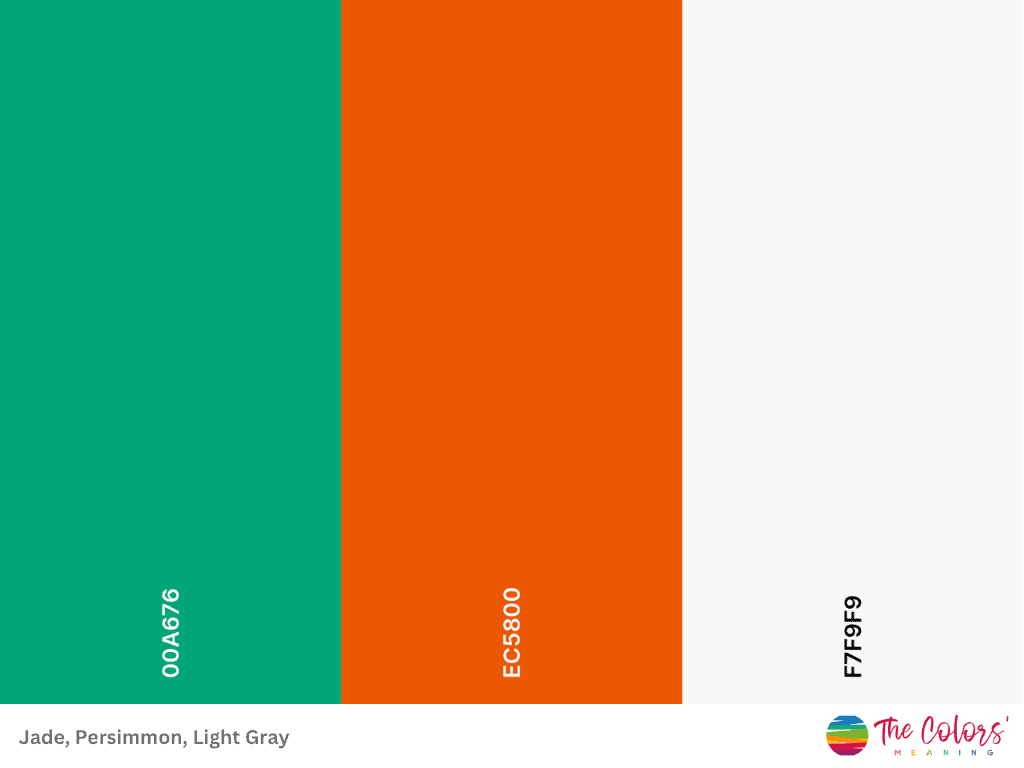
Hex codes: Jade (#00a676), Persimmon (#ec5800), Seasalt (#f7f9f9)
Turquoise
Since orange and red mixtures stand face to face on the color wheel with blue-greens, turquoise is one of persimmon’s complementary colors. This combo not only offers a beautiful contrast but also a balance between enthusiasm and calm, peace and creativity. After all, the meaning of turquoise is about peace, serenity and calm.
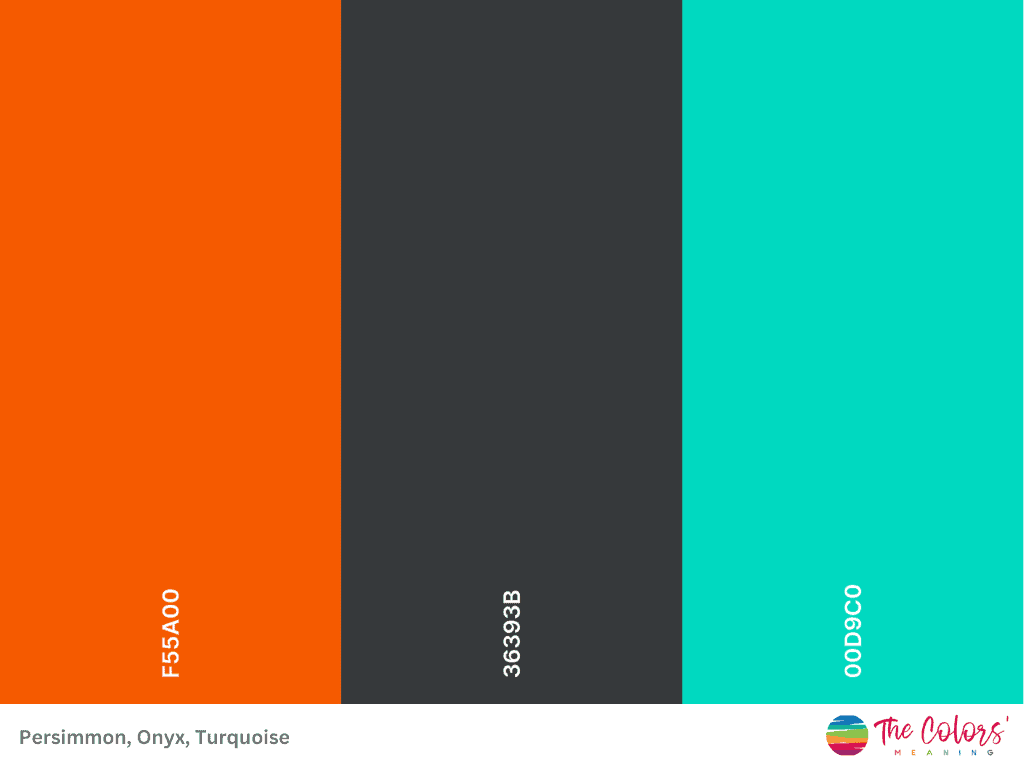
Hex codes: Persimmon (#f55a00), Onyx (#36393b), Turquoise (#00d9c0)
Forest Green
This combo creates a strong contrast between the deep, earthy tones of forest green and the vibrant warmth of persimmon.
You can use persimmon as an accent color against a backdrop of forest-green walls.
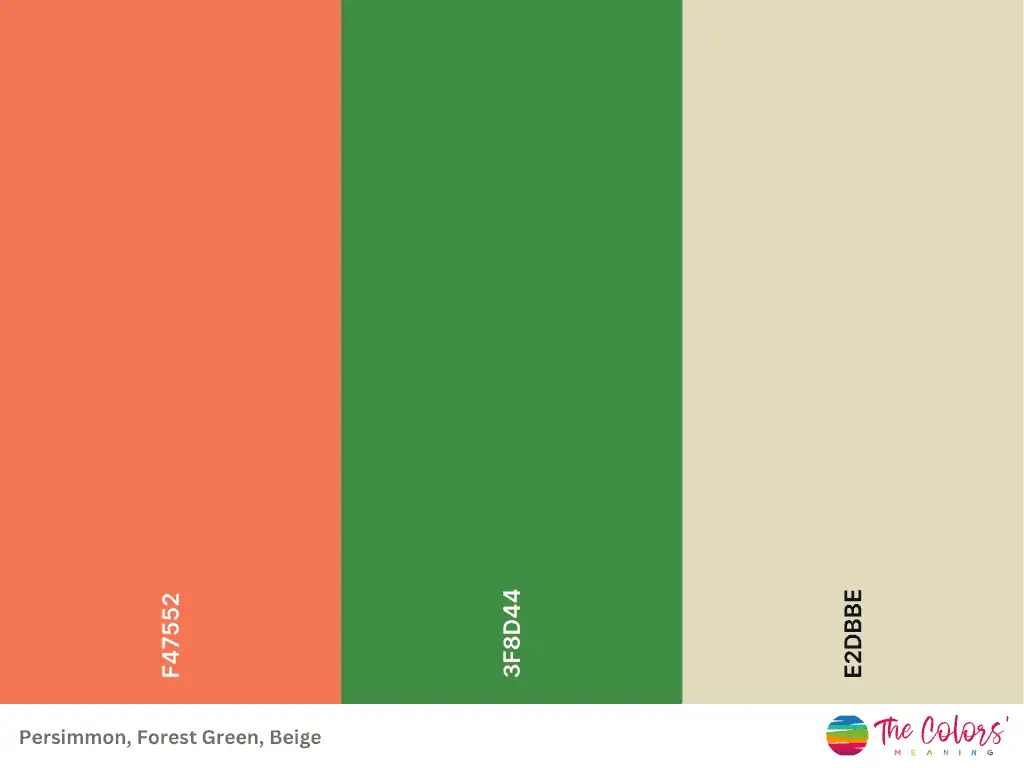
Hex codes: Persimmon (#f47552), Forest Green (#3f8d44), Pearl (#e2dbbe)
Dark Brown
Dark brown is another color that goes well with persimmon. This is a monochromatic color scheme since both colors are variations of orange. Sharing warm undertones, this combo creates a sense of color harmony.
You can combine them with linen, a neutral and soft beige color that can provide balance and a sense of calm.
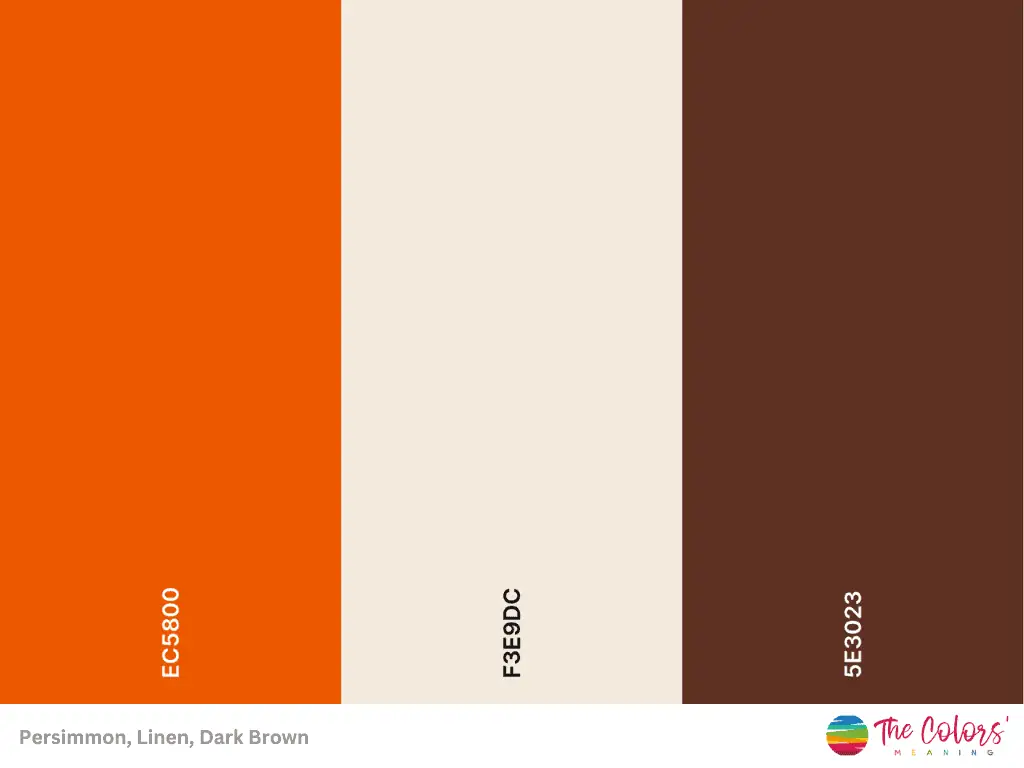
Hex codes: Persimmon (#ec5800), Linen (#f3e9dc), Caput Mortuum (#5e3023)
Gray
If you prefer a more understated approach to design, combining persimmon with neutral tones creates a sophisticated and timeless look. Persimmon goes well with shades of gray, beige, or ivory, creating a calming and balanced atmosphere.
If you want to soften the vibrant excitement of this red-orange, you can combine it with gray, the perfect neutral that symbolizes maturity and balance.
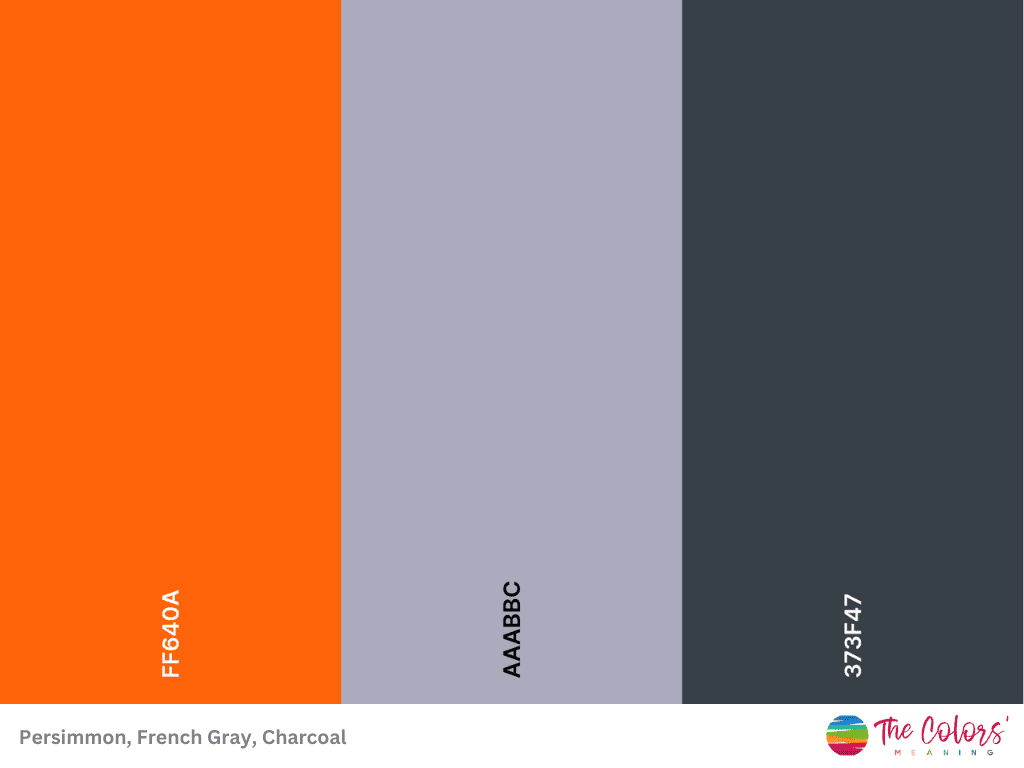
Hex codes: Persimmon (#f55a00), French Gray (#aaabbc), Charcoal (#373f47)
Teal
This is another example of complementary colors.
Teal, especially teal green, with its deep, cool, and calming qualities, provides an excellent contrast to the warm and vibrant nature of persimmon. Moreover, it adds balance to your design.
Nearly peach is a soft neutral that balances the bold dark teal and vibrant persimmon.
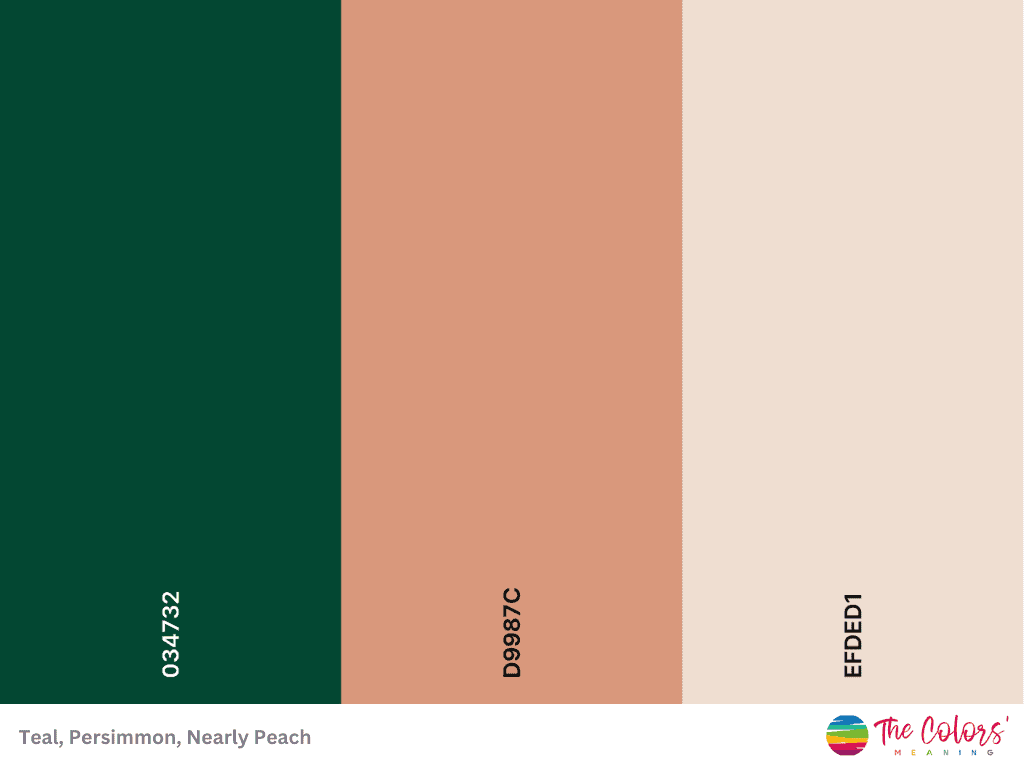
Hex codes: Dark Teal (#034732), Persimmon (#d9987c), Nearly Peach (#efded1)
Gold
For a touch of luxury and glamour, consider incorporating metallic accents into your persimmon-themed space. Shades of gold and brass are excellent choices that can elevate the overall design.
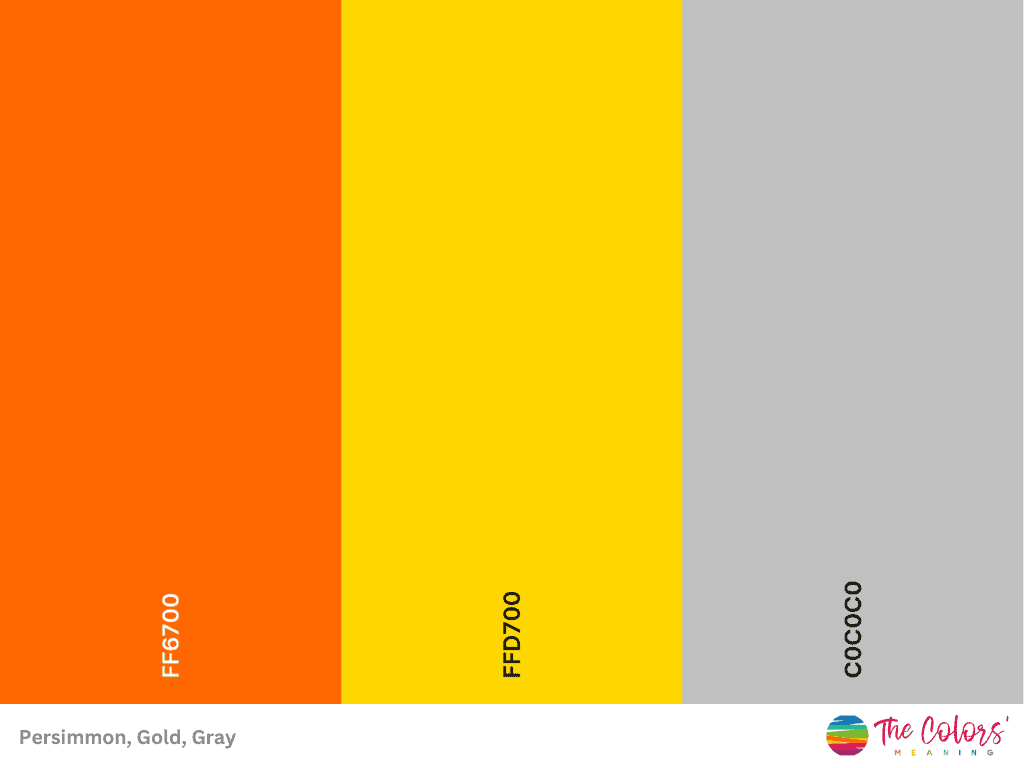
Hex codes: Pumpkin (#ff6700), Gold (#ffd700), Silver (#c0c0c0)
Electric Blue
Bright shades of blue pair well with persimmon, creating a vibrant and eye-catching color combination. Electric blue is a great choice. It is cool and refreshing, while persimmon is warm and energetic.
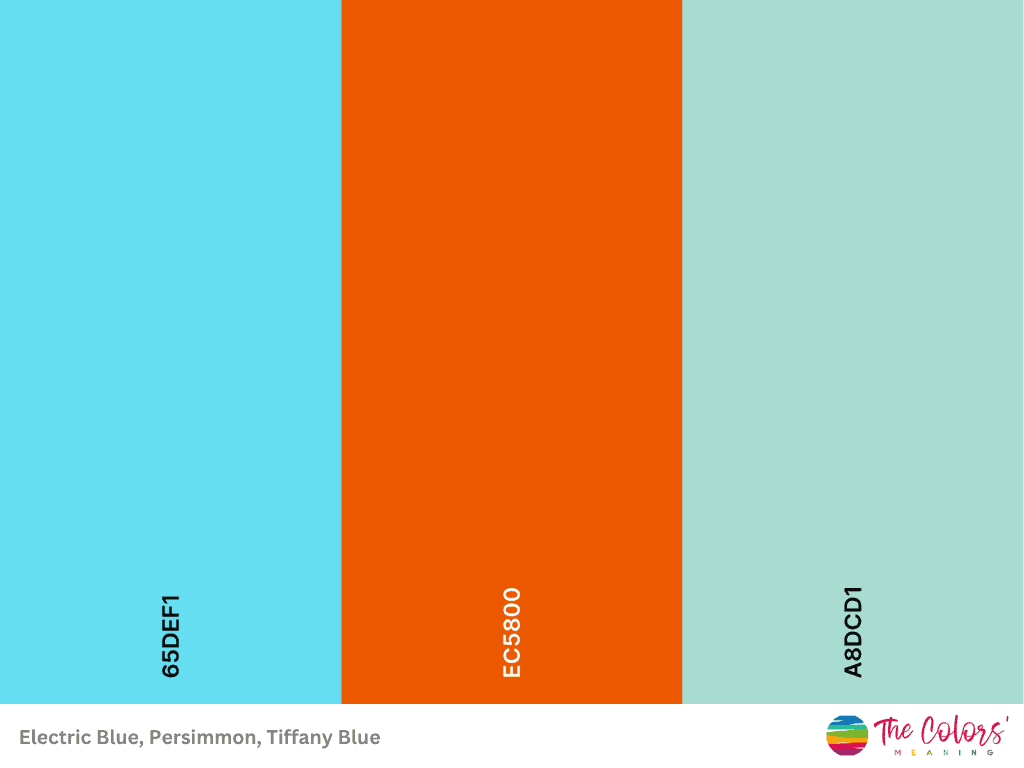
Hex colors: Electric Blue (#65def1), Persimmon (#ec5800), Tiffany Blue (#a8dcd1)
Baby Blue
Baby blue is a cool and calming shade that complements the warmth and vibrancy of this orange-red shade, acting as a soft and soothing backdrop.
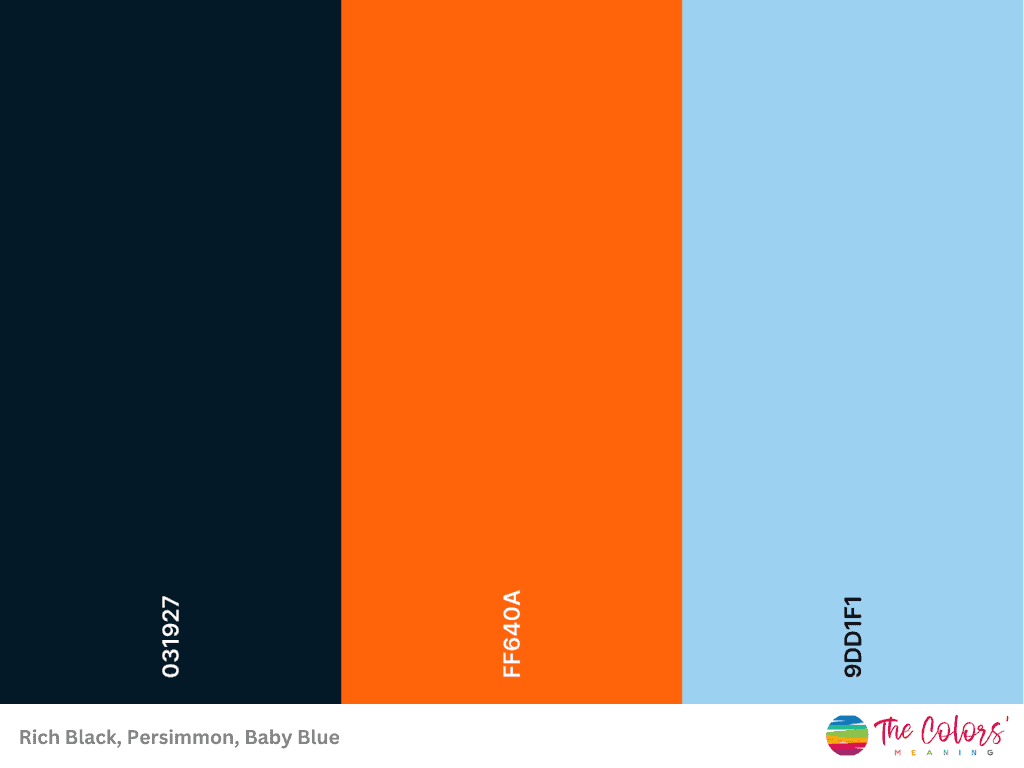
Hex codes: Rich Black (#031927), Persimmon (#ff640a), Baby Blue (#9dd1f1)
Did you enjoy this article about the color persimmon? Share this with your color-savvy friends.

